Serendip is an independent site partnering with faculty at multiple colleges and universities around the world. Happy exploring!
Notes Towards Day 11 (Tues, Feb. 21): Tasting (The Book) of Salt

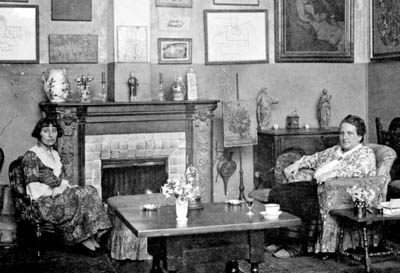
"She wants to see the stretch marks on my tongue..."
I. coursekeeping
signing in
naming
finishing The Book of Salt
going to hear Tyrone Werts talk about Life After Life
looking forward to two events next week:
this weekend you have a very specific posting required-->
5 p.m. Sun, Feb. 26: post on-line a proposal for the remainder
of our semester's work together. Begin with a paragraph or two
of a mid-semester evaluation of how we're doing in learning together:
what's working? What needs working on? What should we keep,
of our shared practices? What might we change up? Turn then from
questions of "form" to those of "content": What other genres,
geographies, forms of gender and sexuality studies would you
like to explore, if the remainder of the class were an independent study?
What do you recommend our exploring together? Why? How
action-based or action-directed do you want our work to be?
I have two more weeks of material planned for after break
(wiggle room, to order new books, do some course planning),
but we will spend next week selecting material together for
NINE [AS YET UNPLANNED] CLASSES.
the following weekend, 8 p.m. Fri, Mar. 3: second 4-pp. web event,
exploring the connections between various forms of feminist thinking
in different geographical locations. Or...feminist rituals? Feminist language?
Feminist icons (Gayatri Spivak, Gertrude Stein?) Feminist texts
(Jane Eyre, Wide Sargasso Sea?)
conferences welcomed but not required....
e-mail conversations, ditto!
questions?
II. From our Sunday evening digital "diablog":
mbeale's discomfort with the activist documentary form:
the documentary seemed to so determinedly manipulate what
little access I was being given into that of a role I was not free
to pick. I was left with little space to come to my own conclusion
about what I had just seen ... as a viewer, I felt thrown to the mercy
of the documenters' views ... instead an honest look into how ...
relationships form under the pressure of institutional prostitution,
or even a positive scene to contrast the violence. By the end of
this film, the viewer can easily still feel a member of a community
that would still alienate and dismiss these women as untouchable
prostitutes ....
melel: mbeale, I have the same feeling as you do. I do like
documentaries a lot ...documentaries enable me to experience
so many things that I may never have chance to experience in
my real life. But after watching Born Into Brothels, I wondered
if the movie can be called as a documentary ... this movie is
not fairly objective ... Is this way of exposing the lives of
children living in brothels great humanitarianism or cruelty?
dchin: How might the film have been made in a more democratic
way? ... is a fuller representation even possible? ...have there been/
are there filmmakers who try to do this? What are their perspectives/
techniques? What is the critical film theory regarding objectivity, especially
in documentary-making?
evolution from "boring films about social problems"/"discourse of sobriety" to
current awareness of liability of images to digital manipulation and discourse:
documentaries use all the strategies of fictional construction to get at truth,
which matters, but is not transparent or guaranteed....
further discussion about the oxymoron of "feminist documentary film"?
Annette Kuhn, "Passionate Detachment": "A feminine language would
be more open, would set up multiplicities of meanings...
[in cf,] a cultural practice calling itself feminist may actually be characterised
by some degree of closure: a restricted range of possible readings."
see also Julia Lesage, "The Political Aesthetics of the Feminist Documentary Film":
The intent is political. Yet the films' very strength, the emphasis on the experiential,
can sometimes be a political limitation, especially when the film...offers little
or no analysis or sense of collective process leading to social change.
in contrast, the complaints about "Lifting Belly"
were that it was TOO undirected
(equal opportunity dissatisfaction....!)
aybala50: with Lifting Belly I was clueless ... to be honest I was bored
and skimmed the whole thing .... Are these poems feminist? In what
way? Talking about sexuality from a women's point of view? What
makes a literary work, a poem, a movie, or rather anything feminist?
sekang: I didn't even know that 'lifting belly' was supposed to be
sexy or even feministy .... why did the author make it so hard to
catch the message?
bluebox: I did not understand Lifting Belly when I attempted to
read it for class .... it just doesn't make sense to me any way I look
at it ....I skimmed ... for important words and gave up .... I assumed
there was a male and a female, because that's usually how things are
.... Unless it points out an issue in gender rights, I don't think there's
a point in letting us know that they're both women. If it's real love,
it doesn't matter who's doing the loving.
sara.gladwin: When I first read Lifting Belly, I was frustrated by my
own lack of understanding ... "All of it is a joke. Lifting belly is no joke.
Not after all." These lines seemed to stick inside my mind, as it
mimicked how I felt about Lifting Belly. At first, it seemed like a joke,
nonsense. But as I reread the poem, the flow of conciousness and
the blurring of meaning seemed to become sensical. Lifting Belly is
no joke, not after all.
meowwalex: there are places in The Book of Salt that seem like
they could be imitating a stream of consciousness form [of "Lifting Belly"]
.... "Quinces are ripe, GertrudeStein, when they are the yellow of canary
wings in midflight. They are ripe when their scent teases you with the
snap of green apples and the perfumed embrace of coral roses. But
even then quinces remain a fruit, hard and obstinate--unless, GertrudeStein,
until they are simmered, coddled for hours above a low, steady flame....
a color you can taste...love is not a bowl of quinces yellowing in a
blue and white china bowl, seen but untouched."
III. explain what's going on here, by looking back @ the surprising
arrival of French feminism last Thursday (so long ago....)
In the 1970s a group French feminists (Helene Cixous, Luce Irigaray,
Julia Kristeva, Monique Wittig) argued that writing and philosophy
were phallocentric, and introduced the concept of an alternative
they called l'écriture féminine (= female, or feminine writing), "writing
from the [female] body," re-structuring language use in order better
to represent the biological rhythms of female experience (see
especially Irigaray's essay on "This Sex Which Is Not One").
This concept is of course problematic --> primarily in the way that
epeck suggested: it is essentializing in its assumptions about
what the female body does/is--and also questionable in its
elision of the move from the biological to the cultural
(you might have sex in one way, and write in another!).
It has been roundly challenged
--see Christine Delphy, "The Invention of French Feminism: An Essential Move"
(50 Years of Yale French Studies : A Commemorative Anthology, Part II, 2000)--
as expressing "an outdated epistemological framework...that it has all been
decided for them in some part of their hormone-influenced cortex... which they
experience ... as irresistible impulses...
... our psychological make-up ... is being shattered by the findings of
feminism about the social construction of gender ... there is no
human nature ....There is no "beyond" (or indeed 'before")
social construction ... the progress of social constructionist views
is ... threatening ... because they let us envision a future where
we might not have gender to rely on as a basis for our personal identity.
And! yet! there is an insight in this work that I think we might attend to,
in the attention it gives to the immense resources of the unconscious,
the invitation it offers that we might write in ways that free us from
"the superegoized structure," and so forge an "antilogos weapon"
(Cixous, "The Laugh of the Medusa"). It's not particularly (or "essentially")
female/feminine (hwink re: e.e.cummings) but writing differently
(more "wildly," less "referentially"?) might well serve feminist aspirations....
which brings us back (of course, heh, heh) to Gertrude Stein:
The Book of Salt, p. 117: "too often, words limit and deny..."
Cf. Kathy Acker's "Seeing Gender":
"What if language need not be mimetic?"
...if "language has no discernible mimetic meaning"?
"Literature is that which denounces and slashes apart the
repressing machine at the level of the signified."
"Stein's poetic interrogates the very surveillance of visibility....
offers the promise of freedom in a language that would
correct deviance, a language that...offered very little in the
way of a lexicon for lesbian partnership....the meanings
produced are variable, multiple, and provisional....Stein...
repeatedly overturns moments of clear referentiality..."
But REALLY: CAN words be non-referential?
Can they NOT signify? (Is that why we "skim"?
we can't stand not making meaning...?)
w/out interpreting their "meaning"?
IV. Let's test this out, working from the opposite direction....
write a paragraph describing this image:

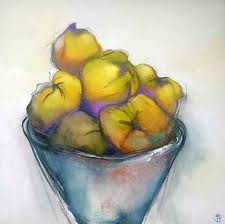
"Quinces are ripe ... when they are the yellow of canary
wings in midflight .... But even then quinces remain a fruit,
hard and obstinate ...until they are simmered, coddled for
hours above a low, steady flame....a color you can taste...
love is not a bowl of quinces yellowing in a
blue and white china bowl, seen but untouched."

Here is Truong/Binh's description:
"I am ... enthralled by her upper lip with its black hairs twitching
gently as she speaks. Her moustache, I think, would be the envy
of all three of my brothers, who could only aspire to such definition
after weeks' worth of unfettered growth. The arc of hair, like a
descended third eyebrow, is topped by a solemn monument to
the god of smells. Protruding from her forehead, abruptly billowing
out as it reaches her eye sockets, it is not so much a nose as an
alterpiece that segregates the left side of her face from her right.
Moving northward, her facial features disappear underneath a
skullcap of hair, dark, absorbing the late-afternoon light. I am
overwhelmed by the intrusiveness of it all until I look into her eyes.
They live apart from their housing. Chasing the light that gilds this
city in early autumn, her irides are two nets gently swooping over
a band of butterflies. Catching the light, the circles erupt, bright
with movement, the flapping and fanning of many colored wings"
(The Book of Salt, p. 25).
Cf. her/his descriptions w/ our own....
how are they like-and-different?
How do they comment on one another?
What might they reveal to us about the difference
between how words and images operate (on us)?
V. Let's go back to the photographic techniques the novel uses,
its reliance on photographs to open and end:
what does that accomplish?
"Of that day I have two photographs and, of course, my memories...." (p. 1)
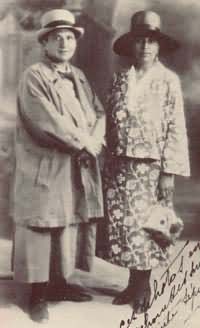 |
 |
This photograph of her and Miss Toklas, the second of two that I have of that day,
was taken on the desk of the SS Champlain. It captures my Mesdames perfectly.
I am over there, the one with my back turned to the camera ... alongside the
photograph taken at the Gare du Nord ... I am partial to the one of them at
the train station.
GertrudeStein and Miss Toklas are perched on the bench ahead of me. My
Madame and Madame are posing for a small group of photographers who
have gathered for the occasion. GertrudeSein looks almost girlish. The folds
of a smile are tucked into her ample cheeks. Miss Toklas looks pleased but
as always somewhat irritated, an an oyster with sand in its lips, a woman
whose corset bites into her hips...."
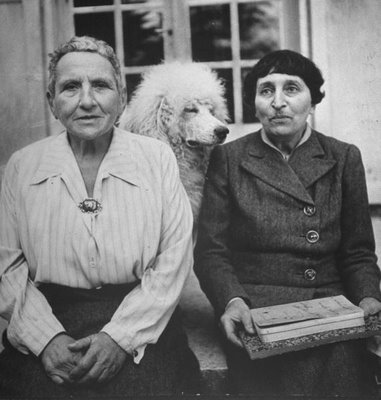
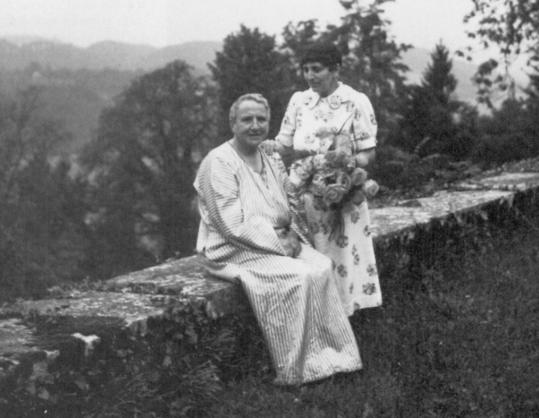
The Accessibility and Assailability of Pictures:
are words more "assailable,"
more subject to common testing?
.
Between sensations (more generally),
and the words which represent them?
| Attachment | Size |
|---|---|
| Werts.jpg | 190.29 KB |


